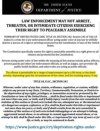Standing before his colleagues on October 19, 1970, Harvard’s
Dr. Edward H. Kass gave a speech to the annual meeting of the Infectious Diseases Society of America that would likely get him run out of this same profession today. At the time, Dr. Kass was actually the President of the organization, which made the things he had to say about vaccines and their impact on the reduction in American mortality rates even more shocking, at least by today’s standards. Forty-eight years after Dr. Kass’ speech, vaccines have taken on a mythological status in many corners of our world, hyped up by the people who benefit the most from their use. Of course vaccines saved the world. Of course every child should get every vaccine. If you don’t vaccinate, you will enable the return of deadly childhood diseases. If you don’t vaccinate, your child will die. If you question vaccines, even a little, you’re an “anti-vaxxer” who should be shunned and dismissed!
But what if most of the history about the role vaccines played in declining mortality isn’t even true?
In his famous speech, Dr. Kass took his infectious disease colleagues to task, warning them that drawing false conclusions about WHY mortality rates had declined so much could cause them to focus on the wrong things. As he explained:
“…we had accepted some half truths and had stopped searching for the whole truths. The principal half truths were that medical research had stamped out the great killers of the past —tuberculosis, diphtheria, pneumonia, puerperal sepsis, etc. —and that medical research and our superior system of medical care were major factors extending life expectancy, thus providing the American people with the highest level of health available in the world. That these are half truths is known but is perhaps not as well known as it should be.”
Dr. Kass then shared some eye-opening charts with his colleagues. I’m trying to imagine a President of the Infectious Diseases Society of America sharing one of these charts today at a meeting of public health officials. I picture someone turning the power off for the room where he’s presenting and then he gets tackled and carried off the stage…here’s the first example of a chart Dr. Kass shared in 1970:
But wait a minute, Dr. Kass’ chart doesn’t even include the measles vaccine…what gives? Well, in 1970, the measles vaccine was just beginning to be rolled out, and as you can clearly see, measles had long since experienced a dramatic decline in mortality. With Pertussis (Whooping Cough), he produced a similar chart:
In this case, you can actually see when the Pertussis vaccine was introduced. He also showed a chart for scarlet fever, which furthers the confusion about the role of vaccines, because there’s never been a scarlet fever vaccine, and yet the chart of a huge decline in mortality from scarlet fever looks very similar to measles and pertussis:
What’s the point?
Dr. Kass was trying to make a simple point to his colleagues, but one with profound implications for public health. His point was so important, I’m going to quote him in really big font to try and drive it home:
“This decline in rates of certain disorders, correlated roughly with socioeconomic circumstances, is merely the most important happening in the history of the health of man, yet we have only the vaguest and most general notions about how it happened and by what mechanisms socioeconomic improvement and decreased rates of certain diseases run in parallel.”
Dr. Kass pled with his colleagues to be open to understanding WHY infectious diseases had declined so dramatically in the U.S. (as well as other first world countries). Was it nutrition? Sanitary methods? A reduction in home crowding? (We’ve since learned the answer to all three questions is, “Yes.”) He encouraged his colleagues to be careful not to jump to conclusions prematurely and to maintain objectivity and “devote ourselves to new possibilities.”
Luckily for us, Dr. Kass’ speech that day has been saved for posterity, as it was printed in its entirety in a medical journal. In fact, it’s a journal that Dr. Kass himself founded,
The Journal of Infectious Diseases, and his speech is called, “
Infectious Disease and Social Change.” There are a number of things about Dr. Kass’ speech that I found breathtaking, especially given that he was the President of the Infectious Diseases Society of America. Namely:
- He never referred to vaccines as “mankind’s greatest invention” or one of the other many hyperbolic ways vaccines are described all the time by vaccine promoters in the press today. Vaccines weren’t responsible for saving “millions of lives” in the United States, as Dr. Kass well knew.
- In fact, he never gave vaccines much credit AT ALL for the developed world’s dramatic mortality decline. Which makes sense, because none of the data he had would have supported that view. Which made me wonder, “has anyone tried to put the contribution of vaccines to the decline in human mortality in the 20th century in context?” Said differently, is there any data that measures exactly how much impact vaccines had in saving humanity? Yes, indeed there is. Read on.

babylonbee.com














